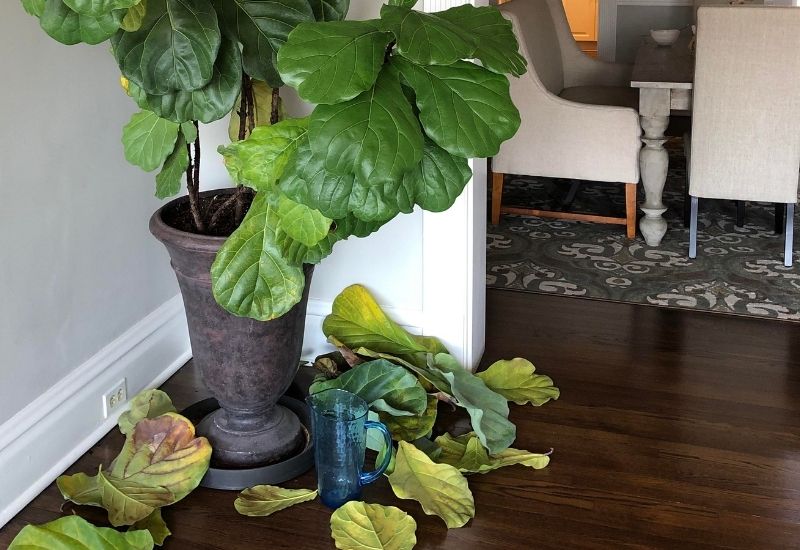
The fiddle leaf fig (Ficus lyrata) is a popular houseplant from the tropical rainforests of western Africa. Its large fiddle-shaped leaves create a dramatic display in the home, but it can be fussy about its care.
One of the first signs your fiddle leaf fig isn’t satisfied with its care is the sudden dropping of its leaves.
While fiddle leaf fig leaves can often fall off (especially the lower leaves) as a normal part of their life cycle. However, sometimes, when your plant’s leaves losing it’s healthy green leaves, it’s a worrisome problem.
Fiddle leaf figs react to stress by dropping their leaves. The most common cause is over or under watering or extreme temperatures. However, there are other reasons for a fiddle leaf fig losing leaves. Your fiddle leaf fig may drop its leaves if you move it to a new location or if its lighting needs are not met.
Consider the following reasons for fiddle leaf fig leaves fall off and making the necessary changes to correct the problem, and your fiddle leaf fig will reward you with healthy new growth.
Six Reasons for Fiddle Leaf Fig Leaves Falling Off
The quick answer to why a fiddle leaf fig is losing leaves is that the plant is under stress. But the cause of your fiddle leaf fig’s stress can vary.
Check out these common reasons for stress that lead to a fiddle leaf fig losing leaves.
1: Improper Watering
Both over and underwatering can cause stress to your fiddle leaf fig, and it will likely react by shedding some of its leaves.
Although it may seem contradictory, both over and under watering can prevent your plant from up-taking the water and nutrients they need to thrive. Here’s why.
Underwatering. It is easy to understand why underwatering would leave your fiddle leaf fig plant struggling to get the water and nutrients it needs because there simply isn’t enough water in the soil to support the plant’s growth.
If the soil in your fiddle leaf fig’s pot is dry and pulls away from the sides of the pot, underwatering is likely the cause of its leaf drop.
In underwatered plants, the leaves will typically develop spots on the edges and begin to curl inward.
Eventually, the leaves will turn yellow or brown and crispy and fall from the plant. Dropping leaves from underwatered plants can affect all the leaves on the plant, not just the lower leaves.
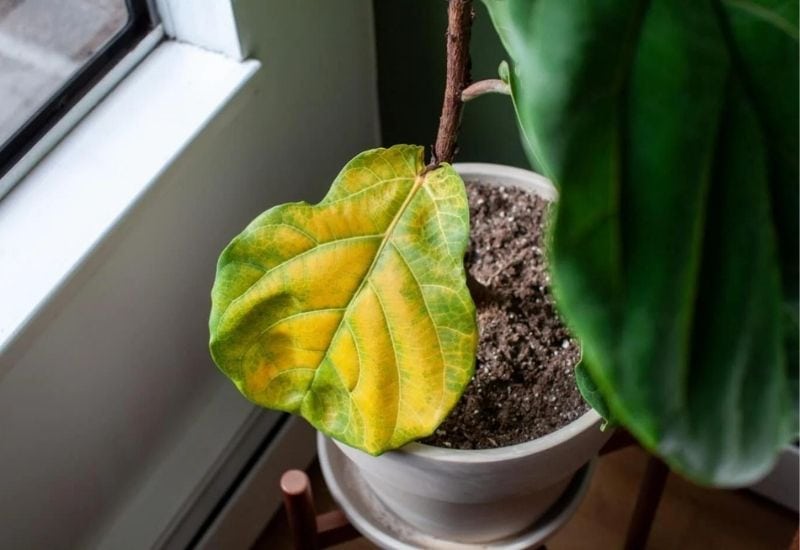
Overwatering: Ironically, overwatering your fiddle leaf fig can also make it impossible for the roots to uptake water and nutrients.
This happens because the water fills all the pores in the soil and chokes out the oxygen the roots need to function correctly. If left untreated, overwatering can lead to root rot and kill your plant.
Leaf drop from overwatering usually affects the lower leaves first. They may develop brown spots in the middle of the leaves and then turn yellow (or brown).
The leaves generally feel and look limp and droopy, unlike the crispy or brittle leaves common on underwatered plants.
How to Fix Improper Watering
Water your fiddle leaf fig plant when the soil feels dry 2 to 3 inches below the soil’s surface.
Water it to saturate the soil and the water runs freely through the bottom of the pot.
Empty the saucer or catch basin of excess water and wait until the top few inches of the soil dries out before watering it again.
The soil in the bottom of the pot should not dry out completely, but it shouldn’t stay soggy either.
Always check the soil in the pot before you water the plant, and develop a watering routine following your plant’s needs.
The amount and frequency of watering your fiddle leaf fig plant plant needs depend on the size of the plant, its rate of growth, and other environmental conditions.
As a rule, it needs more water in the summer when it is actively growing and less in the fall and winter when the growth rate slows.
Trying to follow a strict watering routine, such as watering the plant once a week instead of watering the plant when it really needs it, can lead to either over or under watering your fiddle leaf fig.
2: Poorly Drained Soil
If the soil in your fiddle leaf fig plant’s pot remains soggy after you water it, the soil is likely draining poorly.
This can happen if the drainage holes get clogged with soil or roots, or you have used unsuitable soil for the pot.
The water should run through the soil and collect in the saucer when you water your fiddle leaf fig. If this isn’t happening, you will need to correct the issue.
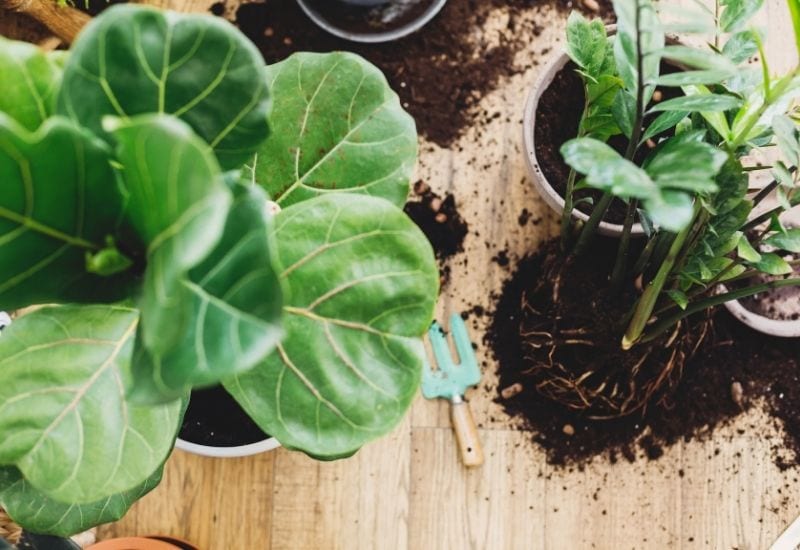
3: Temperature Extremes
As a tropical plant, the fiddle leaf fig can be particular about the ambient air temperature and will react by dropping its leaves if the air is too hot or too cold to suit its needs.
Fiddle leaf figs prefer temperatures between 60 to 80 degrees Fahrenheit. Although they can tolerate routine variations between daytime and nighttime temperatures (and won’t typically complain if you set the thermostat back at night), they do prefer consistency.
Locate your fiddle leaf fig in a room where the temperature remains the same from day to day.
Beware of putting your fiddle leaf fig in a window where the temperatures soar in the afternoon sun and then drop dramatically at night.
Fiddle leaf figs generally perform well in average household temperatures, but consistency is the key.
4: Improper Lighting
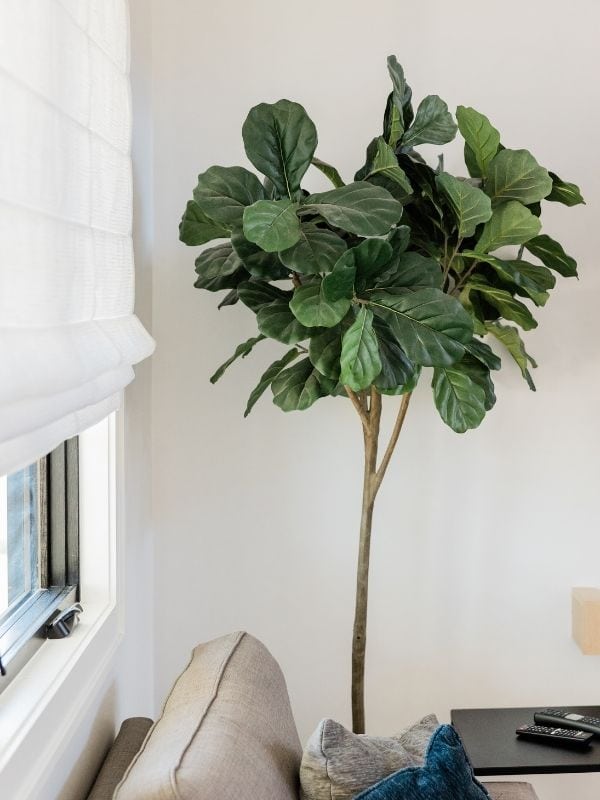
Fiddle leaf figs prefer bright indirect light and will suffer in too much direct sunlight, especially if they are exposed to the harsh rays of the afternoon sun. They will react to either too much or too little sun by dropping their leaves.
Place your fiddle leaf fig plant in a location that receives bright light from a window for at least 6 hours a day.
While it may grow happily in the direct rays from an eastern window, avoid placing it in the direct sun from western or southern windows as this may damage the leaves and cause your plant to drop its leaves.
If your fiddle leaf fig plant is dropping its leaves and it’s not due to improper watering or poorly drained soil, carefully assess the amount and type of light it gets.
Lighting can change through the seasons and may affect the amount of light your plant gets from the window.
For example, when outside trees leaf out in the spring and summer, they may block the sun’s rays on your fiddle leaf fig plant in your home.
Likewise, when the leaves fall outside at the end of summer, your plant may suddenly receive direct sunlight after months of growing happily in filtered light.
5: Environmental Stress
Environmental stress ranges from moving your plant too frequently to Fido whacking it with his tail every time he runs by.
This plant likes things to stay the same and isn’t fond of changes in its environment. Follow these simple ‘rules’ to keep your fiddle leaf fig happy and avoid issues with dropping leaves.
6: Low Humidity
As a tropical plant, the fiddle leaf fig plant is accustomed to high humidity levels. It will suffer if the air in your home is too dry.
Although some prefer to mist their fiddle leaf fig plant to keep the humidity level up, misting is only effective for a few minutes.
Fortunately, there are more effective ways to increase the moisture in the air near your fiddle leaf fig plants.
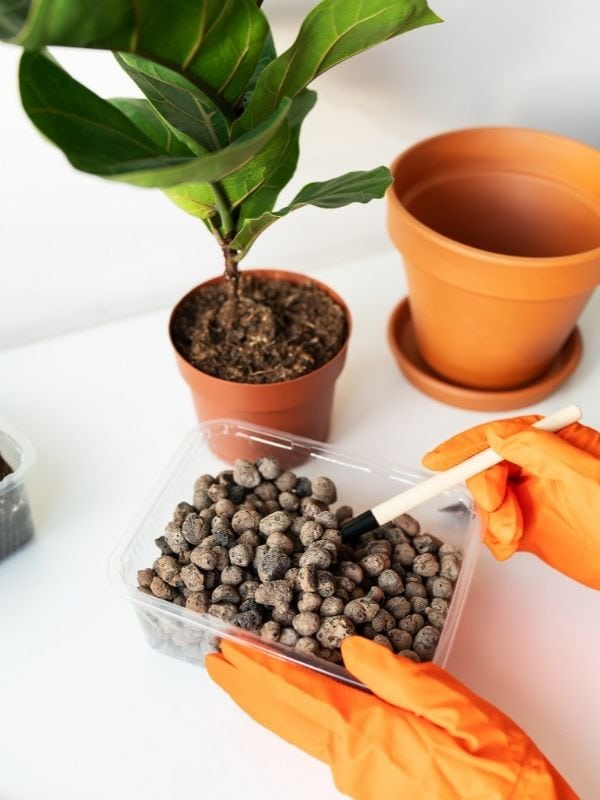
Is it normal for fiddle leaf fig to drop leaves?
All plants drop some leaves as they mature and newer leaves take over the work of performing photosynthesis and making energy for the plant. If your fiddle leaf fig loses an occasional leaf and is otherwise healthy, it isn’t a cause for concern.
Why is my fiddle leaf fig tree losing leaves in summer?
Your fiddle leaf fig plant may drop its leaves in the summer if the temperature rises above 80 degrees or if it is exposed to too much direct sunlight. The soil may also dry out quickly in the summer sun causing your fiddle leaf fig to drop its leaves due to a lack of water.
No More Droopy Leaves!
The cause for fiddle leaf fig leaves falling off is stress, but the cause of the stress can vary. To prevent stress to your fiddle leaf fig tree, you need to be mindful of its growing needs.
With proper watering and allowing the soil to dry out slightly between waterings, adequate light, and the elimination of environmental stressors to your plant, your fiddle leaf fig plant will thrive in the typical indoor environment.

Written By
Amber Noyes
Amber Noyes was born and raised in a suburban California town, San Mateo. She holds a master’s degree in horticulture from the University of California as well as a BS in Biology from the University of San Francisco. With experience working on an organic farm, water conservation research, farmers’ markets, and plant nursery, she understands what makes plants thrive and how we can better understand the connection between microclimate and plant health. When she’s not on the land, Amber loves informing people of new ideas/things related to gardening, especially organic gardening, houseplants, and growing plants in a small space.
